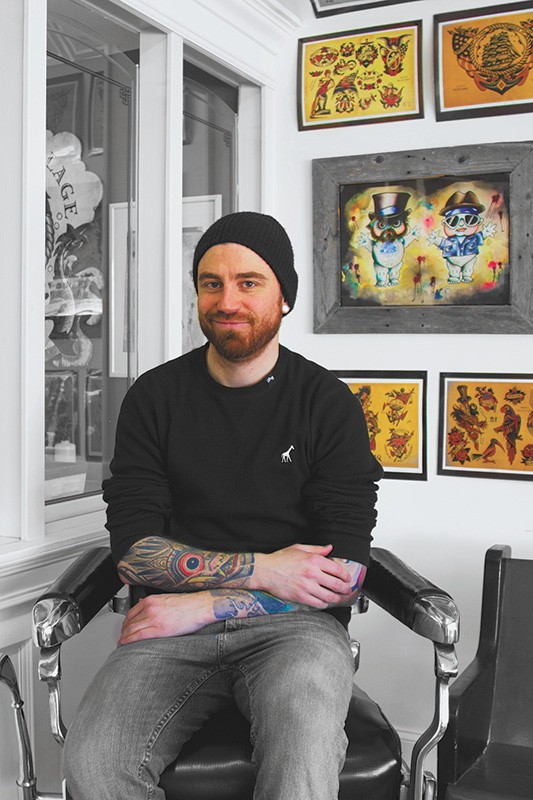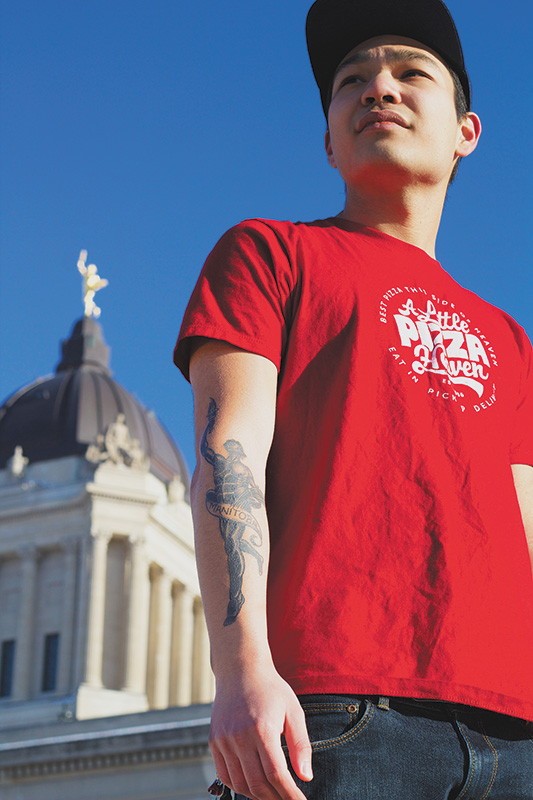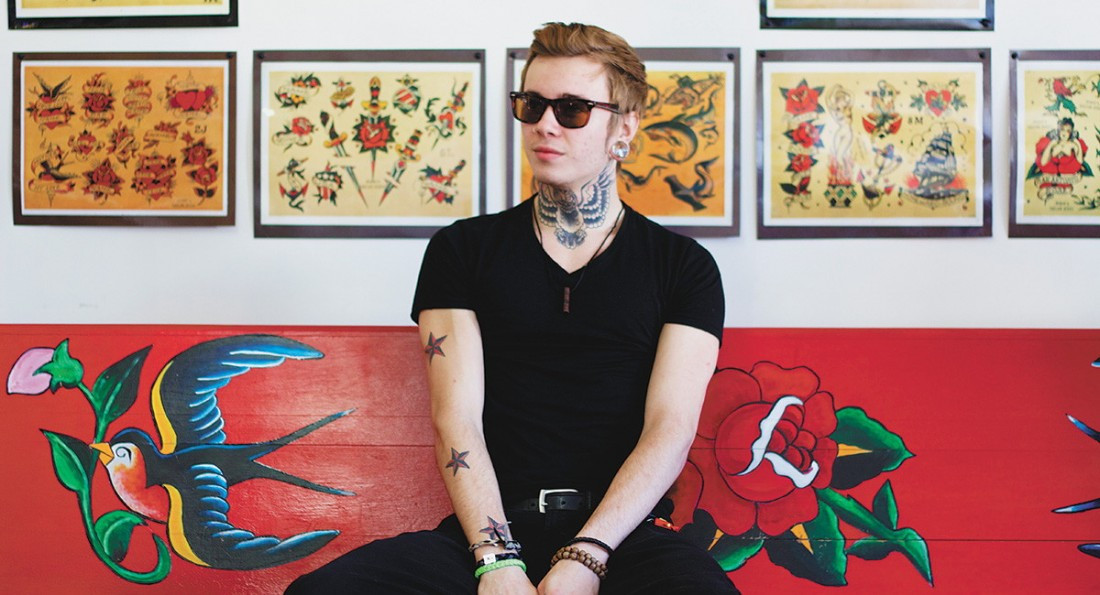Here to stay
Tattoo Culture has gained a sense of permanence in Winnipeg

Photo by Mike Peters

These days, it’s hard to imagine a time when Osborne wasn’t lined with tattoo and piercing shops, and going to summer festivals didn’t mean seeing a whole variety of people’s ink and piercings on display. We don’t even think twice now if a business professional is ‘fully sleeved’ (one or both arms covered with tattoos) even under a suit. For people that are part of the Generation Y demographic, which can be defined as those born between 1983 and the early 2000s, we grew up in a culture of body modification that we never questioned. But this wasn’t always the case, especially not in Winnipeg.
Cam Cook has been part of the tattoo industry in Winnipeg since 1985, when it was still illegal to tattoo in the city. Cook ended up moving to British Columbia to learn the trade because the industry still hadn’t been established here at that point, eventually coming back in the late ‘90s to open a shop.
“Tattooing only became legal in Winnipeg by 1989,” Cook says. “Up until then it was a $10,000 fine if you got caught tattooing…and you had to tell your customers that.”
Cook now owns Osborne Village Ink, one of the numerous tattoo shops in Osborne Village, Winnipeg’s social and cultural epicenter.
“When I started out, a ‘big tattoo’ was about the size of a baseball…as time wore on we all got sleeved up, and now that’s what people come in the door wanting.”
Jeremy Blais has owned Blaze Ink Tattoo’s since 2006, and has been tattooing since 1999; he also feels that the industry has changed in a major way.
“It’s gone from just picking something off the wall or out of the book, to every single piece being custom. People in general have become more aware of the art factor of tattooing.”
Blais recalls a time that even finding a tattoo artist was difficult: “Back then there was also only a handful of shops in the city, and three or four good artists… now there’s actually enough to go around.”
Cook agrees. “Back then, if you didn’t really, really badly want a tattoo - you weren’t getting one,” he says. “In 1989, there was one other young guy, some bikers, and me that all tattooed in Winnipeg. That was pretty much it.”
Now, our city is home to over 30 tattoo and piercing shops, all offering different styles of tattoo art and custom designs. More than ever, people are embracing tattoo culture as a normal part of our society, and the members of Gen Y seems to be paving the way for this, as this generation meets and surpasses the legal age to get tattooed and pierced – which is 18-years old in Manitoba.
Wade Nelson is a professor in the department of Sociology at University of Winnipeg, with a background in Media studies. “Post 2000s, body mods in the form of tattoos and piercings were so available and easy - that is, tattoo and piercing businesses were ubiquitous and the practices were no longer socially transgressive - that most folks were merely following trends,” Nelson says.
“It isn’t outsider behavior anymore – it has become insider behaviour. In 1976, a nostril piercing was like wearing a middle finger on your face. By 2000, it was another place to put a pretty shiny stone.”
“ It’s gone from just picking something off the wall or out of the book, to every single piece being custom. People in general have become more aware of the art factor of tattooing.
Jeremy Blais, Owner of Blaze Ink, on how the industry has changed
Fat Phil is currently managing YOLO Ink, and has been part of the tattoo scene for a total of 26 years, with 17 of them being spent in Winnipeg.
“You see tons of people in professional or service jobs now that are covered in tattoos,” he says. “Tattoo culture has forced workplaces to change the way they hire people; they can’t refuse somebody because they have a tattoo or some visible piercings….everybody has them! And that’s not changing anytime soon.”
So why have Gen Yers been the ones to bring this industry into mainstream culture? There are a whole host of reasons, but in a city like Winnipeg, where the 20-24 age bracket is the third largest segment of our entire population (with a total of 52,445 people in it, as of 2011), this group of young people has a large influence what kind of trends we see emerging in our city.
“Especially with these tattoo-related reality television shows and the way that people walk into those places with crazy stories and walk out with a tattoo, it seems like these days people feel like they need these specific reasons for getting them,” Fat Phil says. “It used to be that people wouldn’t want to get tattoos because they’d look bad when they would get older…Now we are going to have an entire generation of tatted up grandparents.”
Blais believes it has to do with the type of role models this generation had coming up.
“These kids are growing up with their parents and family having things like sleeves and whole back pieces,” Blais adds. “The whole culture of it, movie stars, musicians etc.… everybody has tattoos. It’s accepted as something you just do.”
“Someone who’s born during that time… it’s almost like all their memories would be filled with older people with tattoos,” Cook points out.
It’s hard to ignore the enormity of tattoo culture now, even outside of our city, and it shows no sign of being a fading fad anytime soon. In fact, people are going in the direction of a more visible look with their body art now (covering hands, neck, chest, and face), wanting to show it off to the world as an expression of themselves.
“I was brought up with the idea ‘don’t have a tattoo where a judge can see it’, and that was always embedded in my head… not that I’ve ever done any crime or been in front of a judge, but that’s always the way it has been,” Blais says.
“People now want to get something like a neck or hand tattoo done first, and I don’t think they realize the consequences later in life.”
“When I got into this, getting tattooed was more of a rebellious thing… you did it to not fit in, and that was the mentality of it,” Cook says. “You’d have to do something else to be rebellious nowadays, because having a tattoo is just not going to do it.”
“What it means to the individual getting these mods done is important,” Nelson observes. “But despite their intentions to communicate individuality, I believe that these practices are read by many - if not most - as conformity.”
Published in Volume 68, Number 24 of The Uniter (March 19, 2014)







